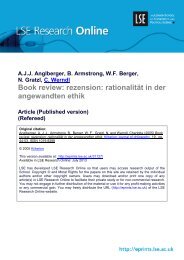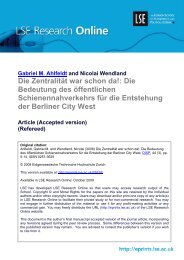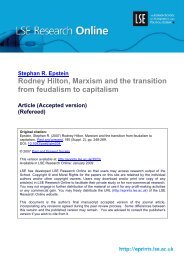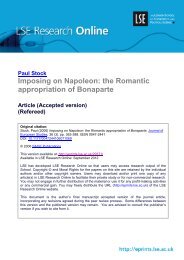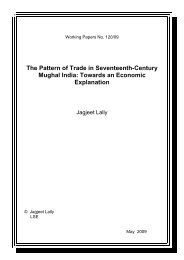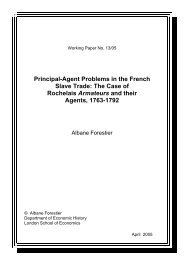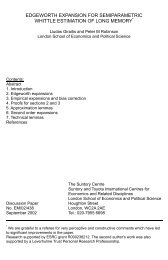The Ramsey Number for 3-Uniform Tight Hypergraph Cycles Article
The Ramsey Number for 3-Uniform Tight Hypergraph Cycles Article
The Ramsey Number for 3-Uniform Tight Hypergraph Cycles Article
You also want an ePaper? Increase the reach of your titles
YUMPU automatically turns print PDFs into web optimized ePapers that Google loves.
<strong>The</strong> <strong>Ramsey</strong> <strong>Number</strong> <strong>for</strong> 3-Uni<strong>for</strong>m <strong>Tight</strong> <strong>Hypergraph</strong> <strong>Cycles</strong> 189<br />
√<br />
By symmetry, we may assume that |Vred| 5s + c0 s.Wefirstprove<br />
that the azure component A contains a matching M (3)<br />
s whose vertex set is in Vblue. Again,<br />
this is true even <strong>for</strong> t =6s− 2.<br />
Observation 7.5. <strong>The</strong>re exists a matching MA = M (3)<br />
s ⊂ A with V (MA) ⊂ Vblue.<br />
Proof. Let Vblue = V ′ ∪ V ′′ be a partition of Vblue such that |V ′ | = s. Since |V ′′ | � 6s − 2 −<br />
(s − 1) − s � 4s − 1, <strong>The</strong>orem 6.1 applied to the induced 2-colouring Kred[V ′′ ] ∪ Kblue[V ′′ ]<br />
of K[V ′′ ] implies that there exists a matching M = M (3)<br />
s in a monochromatic component<br />
of K[V ′′ ] (which is contained in some monochromatic component C in K).<br />
If C is blue, then it must be A, because V ′′ is a subset of Vblue, andwearedone.<br />
Hence assume C = Cred is red. By (7.1), we have C (3)<br />
4 �⊂ Cred. To avoid C (3)<br />
4 in Cred, <strong>for</strong><br />
each edge xyz ∈ M and any vertex a ∈ V ′ , at least one of the edges xya, xza, yza must<br />
be a blue edge, and, consequently, also in A, because a ∈ V ′ ⊂ Vblue. Thus, using all s<br />
vertices a ∈ V ′ and s edges of M, we greedily find a matching MA of size s in A. Clearly,<br />
V (MA) ⊂ V ′ ∪ V ′′ = Vblue.<br />
In view of Observation 7.5 and the assumption (7.1), we know that<br />
C (3)<br />
4 �⊂ A. (7.3)<br />
We distinguish two subcases. In the first one we assume that almost all pairs of vertices<br />
from Vblue are contained in the shadows of at most two red components.<br />
Subcase 2a. <strong>The</strong>re exist two red components C1 red and C2 red<br />
��<br />
�<br />
�<br />
� Vblue<br />
�<br />
such that<br />
�<br />
� \(∂C<br />
2<br />
1 red ∪ ∂C 2 red) �<br />
� < 6t. (7.4)<br />
We now prove a series of observations. Recall that by Observation 6.3 the scarlet<br />
component S exists whenever Vred �= ∅. We now show that in that case one of C1 red and<br />
C2 red equals S or can be replaced by S.<br />
Observation 7.6. If Vred �= ∅, then there exists a red component Cred such that<br />
��<br />
�<br />
� ��<br />
�<br />
�<br />
� Vblue<br />
� � V<br />
�<br />
�<br />
�<br />
Proof. Note that � V<br />
2<br />
2<br />
\(∂Cred ∪ ∂S) �<br />
� = �<br />
�<br />
2<br />
\(∂Cred ∪ ∂S) �<br />
� < 24t. (7.5)<br />
� � � Vblue<br />
1 \ 2 ⊂ ∂S. If|∂Cred | � 18t holds, then with Cred = C2 red<br />
��<br />
�<br />
�<br />
�<br />
�<br />
V<br />
�<br />
\(∂Cred �<br />
∪ ∂S) �<br />
2<br />
�<br />
(7.4)<br />
< 6t + |∂C 1 red| � 24t.<br />
we have<br />
Hence, suppose that |∂C 1 red | > 18t and |∂C2 red | > 18t. We claim that there exist vertices<br />
u, v, w ∈ Vblue such that uv ∈ ∂C 1 red , uw ∈ ∂C2 red ,andvw ∈ ∂C1 red ∪ ∂C2 red .<br />
This follows from a simple graph-theoretic fact.





